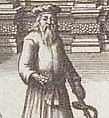In 1621, a gift of £250 from Henry, Lord Danvers (later Earl of Danby) allowed the University of Oxford to take out the lease from Magdalen College of a five-acre tract of meadowland, on a bend of the river Cherwell beyond the East gate of the city, in order to set up a physic garden there. Danvers' gift, together with the benefaction made by Sir Henry Savile to found professorships of geometry and astronomy, promised to transform the teaching of natural philosophy at Oxford. By 1632, the buildings of what is now the University's botanical garden had been erected by Nicholas Stone, a mason who had acted for Inigo Jones, and work had begun to stock it with plants, following the model of earlier physic gardens on the Continent. An attempt to persuade the elder John Tradescant (catalogue nos. 32 and 33 ) to accept the post of gardener failed in 1637, but, by 1641, Jacob Bobart(c.1596-1680), a native of Brunswick, had been appointed to the post, with a lease on the garden of ninety-nine years, and the right to sell fruit and vegetables from it. Bobart's tasks
| |

|
|
| Catalogue 22
|
were 'to dresse manure preserve and keepe the said Garden and from tyme to tyme sett and plant the same with such herbes settes trees and plants as shall be thought requesit and necessarie' (Vines and Druce, p.xvi), for which Danby contracted to pay him £40 a year. Following Danby's death and the sequestration of his lands during the Civil War, Bobart's salary went unpaid for several years, and he lived from the sale of the Physic Garden's produce while the University petitioned Parliament to have his annuity restored. Bobart continued as gardener until his death, and was succeeded in the post by his son, also called Jacob. His care for the Physic Garden won the admiration of many visitors to Oxford, who were impressed by the rare trees and plants which Bobart grew (Evelyn was fascinated by a sensitive plant), by his extraordinary topiary, and, increasingly, by the gardener's own bizarre appearance (see Catalogue 22).
In 1648, an anonymous catalogue of the plants to be found in the Oxford Physic Garden was published, containing details of more than 1,600 specimens, of which only about 600 were native to Britain. Many of the plants came from North America. Although the published Latin and English catalogues were the work of unnamed editors (a second edition of 1658 was overseen by Philip Stephens and William Browne), the listings and descriptions of plants were almost certainly Bobart's work. The English preface to the second edition of the catalogue remarked of Bobart's labours in the Physic Garden:
Thus as the species of all creatures were gathered together into the Arke, comprehended as in an Epitome, so you have the plants of most parts of the world, contained in this garden where they are preserved for thy inspection.
In Bobart's hands, the Physic Garden recreated Eden, in which all the plants of the world had flourished, and provided an example of how hard work and experimental philosophy could restore the fertility of the earth. The garden was also an ark, a refuge from external corruption, and a precursor of a better world to come. |
Falconer Madan, Oxford Books: a Bibliography of Printed Works Relating to the University and City of Oxford (3vols,Oxford,1895–1931),vol.2, p.475; Henry Tilleman Bobart, A Biographical Sketch of Jacob Bobart ([Leicester], 1884); S. H. Vines and G. Claridge Druce, An Account of the Morisonian Herbarium (Oxford, 1914), pp.ix–xxiv; John Newman, ‘The Architectural Setting’, pp.135–77 in Nicholas Tyacke (ed.), The History of the University of Oxford, Volume IV: Seventeenth-Century Oxford (Oxford, 1997), pp. 169–70.
|



